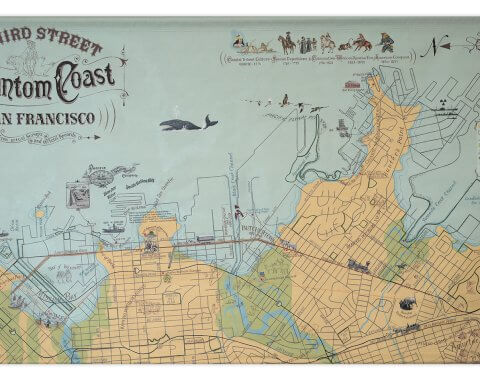Mosaics on the wall, the sound of kids laughing and playing in the yard, a painted eagle, and a sign that says, “LOVE TO LEARN LEARN TOGETHER”. This is what’s visible to a passerby on any given school day walking along Wisconsin Street on Potrero Hill’s southern edge.
Starr King is one two San Francisco Unified School District (SFUSD) elementary schools located in the Hill, along with Daniel Webster. Originally constructed in 1913 on 25th and Utah streets at what’s now Bryant Elementary School, Starr King was rebuilt on 1215 Carolina Street next to the Potrero Annex-Terrace housing complex in 1958.
Edward Hatter, Potrero Hill Neighborhood House (NABE) executive director, now in his 60s, grew up in the neighborhood and witnessed how it’s evolved over the years, from a working-class community filled with families in the 1950s and 1960s, white flight to the suburbs, the lingering effects of the crack epidemic in the 1980s that especially beset Black families, impacting school attendance and test scores, to a burst of gentrification that began in the late-1990s but has yet to create substantial improvements to Annex-Terrace.
“Then came around 2005 when the district pitched the idea of starting immersion programs in elementary schools,” said Hatter.
In jeopardy of being closed due to a dearth in enrollment, Starr King implemented a Mandarin Immersion (MI) program in 2006, joining SFUSD’s 16 dual-immersion program schools, all with long waiting lists. Once a school that served mainly Hill residents, including those living in Annex-Terrace, Starr King started attracting Asian- and European-American families from other parts of San Francisco. Enrollment doubled by 2012.
“Sounded like a great idea to me too, focusing on cultures and languages and giving our children an opportunity to learn a different language that could only improve their education…we thought…but as the immersion programs came in, the parents came with them,” Hatter told the View. “We now have upper middle-class parents and Asian parents who are used to paying for their children’s Saturday school to get extra education and culture to their children, while the low-income children are making room for the immersion program.”
For the first five years after the MI program was launched the school maintained two parent-teacher associations, one for general education – now called experiential learning, EXL – one for the immersion program. Since the EXL PTA wasn’t especially active, the immersion PTA dominated.
“I was questioning why the low-income general education kids weren’t entering or getting promoted into the immersion program,” said Hatter. “We actually had three kids enter over the course of five years, and they didn’t stay, and we wondered why. I had an issue because it was a school, one school, but it was operating as two, where the kids didn’t even eat lunch together.”
“There has also been no outreach from SFUSD or the school to encourage local kids living in Potrero Hill’s public housing that they can be a part of the school’s Mandarin Immersion program,” said one parent whose children previously attended Starr King. “There is misinformation happening. I learned from several parents in public housing that administrators advised them that their kids in kindergarten did not qualify for the Chinese program because they couldn’t speak Chinese. As administrators and teachers know, at all immersion schools in SFUSD, there is no requirement for a child to have any background at all in the target language during the early grades.”
Many parents of Starr King students who spoke to the View, but who didn’t want to be named, agreed that the school faced challenges, though some felt progress was being made to integrate the programs.
“During recess you don’t know there are two programs but if you walk into school during school time you see there is a sort of segregation,” one parent told the View. “A challenge that the PTA has worked on is how do we be more inclusive, so everyone feels included and wants to get involved and how do we make sure it’s not the same parents interacting with the same parents all the time. This is one of the most frustrating aspects of the school being one of the most diverse schools in the City but not feeling like it is exactly like that because the same parents are interacting with each other.”
San Francisco is the 25th most demographically varied city in the country, with a diversity score of 69, a metric calculated using survey and census data to determine the probability that any two people chosen at random would differ in race or ethnicity. Yet a large portion of its public elementary schools are “segregated,” with most students on many campuses being from a single race or socioeconomic background.
A San Francisco Chronicle article determined that racial and income separation in SFUSD’s schools was related to housing patterns and the student assignment system. The district employs a placement policy that requires students, even those entering elementary school, to submit a ranked list of schools they prefer to attend. Admittance is based on availability. “Tiebreakers” give preferences to those with siblings that have attended the school, applicants to a dual language immersion, such as Spanish or Mandarin; and proximity to the school. Parents tend to prefer schools that fit their demographic and socioeconomic profile. Hard-pressed low-income families, and those for which English is a second language, may not even know they have school choice.
The dual immersion programs started, in part, as an attempt to help diversify San Francisco schools, especially those located in low-income areas where most students were from the African American or Latinx community. While this strategy succeeded in forestalling campus closures, dual-immersion schools largely became microcosms of wider city-wide segregation, in which students were separated by program.
Similar to other public schools, Starr King has a considerable gap in achievement between students with different racial backgrounds. According to 2022 San Francisco Board of Education standardized test scores from elementary to high school students, European- and Asian-American populations are at 70 to 80 percent in terms of reading and math performance, compared to 30 to 50 percent for African American and Latinx students.
“As far as the achievement gap goes, we are at pre-pandemic levels. Although we have seen a rise in some scores for students that we’ve really been working on as focal groups, will there ever be an end to the achievement gap? Not sure,” said Darlene Martin, Starr King’s principal.
In a 2019 San Francisco Bay View article Anne Hennessey wrote about a conflict over how best to dedicate PTA funds. The PTA, primarily composed of MI parents, raises more than $300,000 a year. In the instance she covered, $80,000 was allocated to hiring a MI teacher instead of dedicating funding to GE programs.
Three years later, one parent on the PTA said things have improved.
“Most of that (PTA funding) goes directly to the school in order to fund the hiring of two teachers, one for the Mandarin program and one for the English/EXL program. That way, we ensure that every classroom has a teacher, and the upper grades don’t need to combine classrooms, because the SFUSD allows classrooms up to 33 students, and so the district doesn’t actually provide enough funds for three full teachers for each grade.”
The number of low-income kids attending Starr King from Annex-Terrace has been declining, as evidenced by loss of the school’s Title I status. In 2015, President Barack Obama signed the bipartisan Every Student Succeeds Act (ESSA), which replaced the No Child Left Behind Act, an attempt to hold states and schools accountable for student achievement. Title I of ESSA provides federal monies to districts with high numbers of low-income students to support programs that address achievement gaps.
Under the 2023-2024 budget endorsed by the San Francisco Board of Education, SFUSD was projected to receive $15 million in Concentration Grant Title I funds due to an Unduplicated Pupil Percentage (UPP) of 59 percent, calculated by the number of students eligible for free and reduced-cost meals, English learners, and foster youth. SFUSD distributes these monies to schools that have a UPP of at least 55 percent, to pay for initiatives that assist academically low-achieving students gain access to technology, provide behavioral support staff and counselors, or engage a homeless liaison.
For many years, Starr King was a designated Title I school largely due to the high percentage of low-income students that attended from nearby Annex-Terrace. Two-thirds of the school’s student population is now enrolled in the MI program, which has few low-income learners.
“We haven’t been Title I in a long time,” said Martin. “That goes back to the percentage of students who have free and reduced lunch, the percentage fell from 50 percent to 35 percent. We haven’t had that funding for at least five years, but that goes back to the district demographics.”
Part of the school’s transition is the result of a changing neighborhood. Some Annex-Terrace families transferred their kids to other campuses, feeling that their needs weren’t being met. Others moved due to poor living conditions or because they found better housing opportunities.
“We were sold this pipe dream of revitalization 12 years ago with the HOPE SF initiative and here 12 years later we got one building in a wreck, another building being erected, and then possibilities of a new building with not many units being built in the Annex for low income. But more of it really is a land grab for market rate and mixed-income housing,” Hatter remarked.
Given the declining low-income student population, and ongoing disparities within the school, the View asked Martin about her plan for improving integration and reducing the achievement gap.
“Integration is interesting because as we do it, we find more interesting ways to do it. Given my knowledge of other schools with language immersion programs, it is difficult to have a fully integrated school if programs don’t demographically mirror each other, there is an issue and kids don’t mix. So, we started with integrating field trips, then PE, then specials, and some with academic work. One of the things in addition to that is that we revamped the English program…so in that program, we fill in gaps in background knowledge – field trips or videos or conversations – not just teacher talking and giving handouts. There are still disparities in the school about achievement levels between different demographic groups, so we continue to work on that, but they have done a lot to support students on tutoring after school and integrating.”



